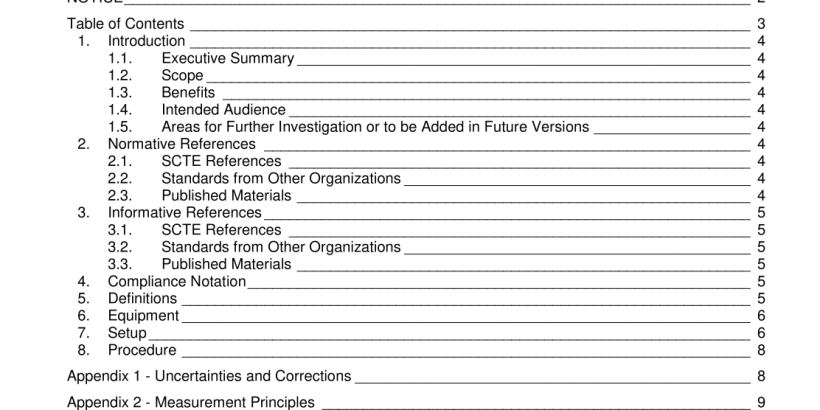ANSI SCTE 62-2018 pdf download.Measurement Procedure for Noise Figure
One class of avoidable errors results from poor setup conditions. A noisy environment and inadequate shielding can allow extraneous signals to pollute the measurement. An oscilloscope connected to the ANFM scope / recorder output will usually show this. Before resorting to the ultimate solution of a shielded room, the integrity of all connections and quality of cables should be checked in order to eliminate or minimize the problem. Dirty or worn items can cause signal loss or intermittent readings, and must be cleaned or replaced. Another avoidable error stems from the fact that the noise figures of many devices vary with source impedance. Since the noise source is switched between “on” and “off” states in making measurements, its output impedance could vary and affect the reading. Using a quality noise source such as that suggested can make this effect negligible. Choice of noise source can, while not intrinsically causing errors, make certain errors more significant. As a rule-of-thumb, the noise source should have as low an ENR as practicable, but not less than about 10 dB below the expected NF being measured. (Note that this means available ENR, which is the noise source output minus the loss of an MLP.) A low-ENR (≈6 dB) avoids the possibility of overloading the DUT. Also, since some ANFMs adjust for higher input levels by adding input attenuation (thereby increasing its own NF), less second-stage correction of the measurement (see below) would have to be applied. Finally, since most low-ENR noise sources have a significant built-in attenuator, they generally have better output RL as well as more constant RL between the “on” and “off” states. On the other hand, if the available ENR is more than 10 dB below the NF of the DUT, there will be so little difference in DUT noise output between the source “on” and “off” states that measurement accuracy of the ANFM itself will be compromised.
The implication of the above discussion is that, for the NF range typically encountered in Cable Telecommunications devices, a low-ENR noise source would not be optimum when used with an MLP, and that a high-ENR (≈15 dB) source would be the better choice. If a low-ENR source must be used, then a matching transformer or a straight (unmatched) connector adapter could be employed. See Appendix 4 – Error Analysis for more information as to the effects of the resulting poorer match on overall accuracy. Unavoidable errors are associated with the instrumentation and with the characteristics of the DUT itself. Of course, the Noise Source and ANFM must be calibrated at proper intervals, but the ANFM will still have some residual linearity errors, in both the NF and gain measurement modes. Also, there will be some error in tracing the noise source calibration (ENR value) to a recognized standard such as the National Bureau of Standards value.
shows the sensitivity of a measurement to the gain of the DUT and the NF of the following stages. Thus, the accuracy of the correction made by the ANFM will depend on how accurately the gain of the DUT is being measured, as well as the accuracy with which its own NF can be determined. The greater the correction that has to be made, the greater the error introduced by any given inaccuracy in these measurements. Therefore, it is advisable to use a low-noise preamplifier between a low-gain DUT and the ANFM input to minimize the amount of this second-stage correction being made by the system. As shown in Figure 1, any preamp used must be included in the calibration. The remaining significant unavoidable error results from mismatch between the Noise Source and the DUT. Assuming that the Noise Source and matching pad are as specified and properly calibrated, the main contributor will be the return loss of the DUT itself. A further discussion of this error is contained in Appendix 4 – Error Analysis.ANSI SCTE 62-2018 pdf download
